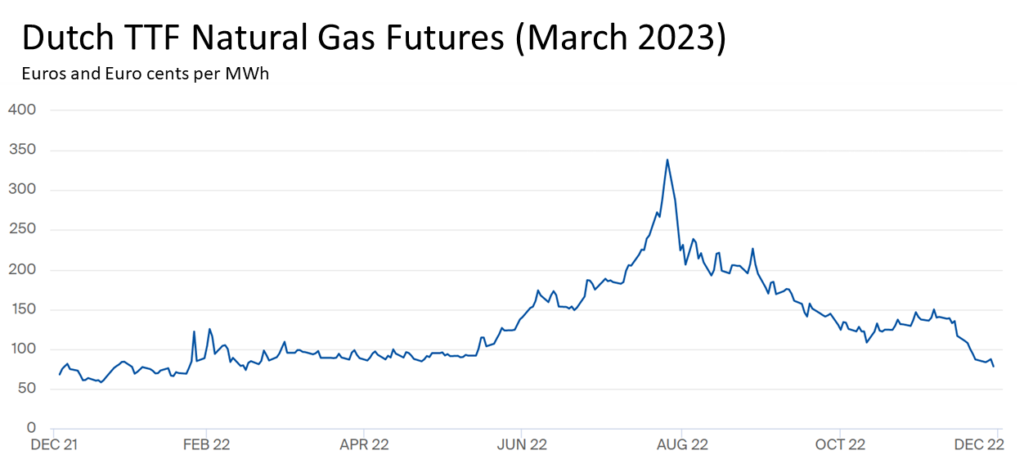[Updates Below] Europe’s second week of winter begins with Frankfurt breaking 60 degrees Fahrenheit. Autumn in Paris (and Berlin and Amsterdam) was remarkably mild. The EU has consumed one-fifth to one-quarter less energy than usual. Much higher costs have also contributed to declines in demand (more and more).
EU natural gas storage facilities are more than 80 percent full (more and more). The price of a March futures contract for natural gas is now less than one-quarter the late August price per the Dutch TTF benchmark (see chart below). (The US Henry Hub price has also fallen.) Even diesel supplies are slightly higher while the price is slightly lower compared to one month ago (more and more).
Happy New Year.
So far, President Putin’s plan to weaponize Western Europe’s winter is not going well. Farther East, today even Kyiv is feeling the upper fifties Fahrenheit. But Putin’s direct attacks on Ukraine’s grid (here and here and here) are a very present and escalating threat to millions.
In a December 28 address to Ukraine’s parliament, President Zelenskyy said, “Today we have to get through and we will definitely get through this winter. Russian missiles and, as they say, “shahed” strikes at our energy sector, at the energy supply of Ukrainians, are an obvious challenge — not only to our state, by the way. When terror strikes against the civilization of life, the world can stand up for both civilization and life.”
In the same speech Zelenskyy offers a Supply Chain Resilience, network-science-oriented vision for rebuilding his nation’s grid, “Now, when the enemy has set himself the goal of destroying us, destroying our energy sector, we set ourselves the goal of becoming a leader in the transformation of our energy sector to counter any threats, any challenges – military, political, economic or even climatic. We have to become – and we will become, as there is no other option – a leader in building modern green energy. This will allow us to create a decentralized energy system that cannot be destroyed by anything, any missile strikes. Today – everyone can see – it is dangerous when cities depend on several large thermal or power plants. A modern city needs decentralized sources of energy.”

+++
January 2 Update: Bloomberg reports, “Benchmark futures settled higher on Monday after initially falling to the lowest level since before Russia invaded Ukraine. While weather forecasts point to temperatures above seasonal norms for most of the region in the next two weeks, Europe still needs to manage its stocks carefully as it goes through the winter.”
January 5 Update: S&P provides a helpful analysis of demand and supply, concluding: “European power prices have fallen to pre-Ukraine invasion levels for winter contracts, as a combination of ample LNG supply, mild weather and a weak economy weighed on the market, while prices further out were firmly higher on the year…”